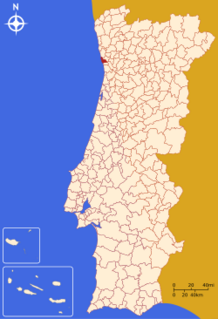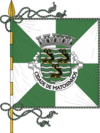Matosinhos facts for kids
Quick facts for kids
Matosinhos
|
|||
|---|---|---|---|
|
Municipality
|
|||
|
|||
 |
|||
| Country | |||
| Region | Norte | ||
| Metropolitan area | Porto | ||
| District | Porto | ||
| Parishes | 4 | ||
| Area | |||
| • Total | 62.42 km2 (24.10 sq mi) | ||
| Population
(2021)
|
|||
| • Total | 172,557 | ||
| • Density | 2,764.45/km2 (7,159.9/sq mi) | ||
| Time zone | WET/WEST (UTC+0/+1) | ||
| Website | http://www.cm-matosinhos.pt | ||
Matosinhos is a city and a municipality in the Porto area of Portugal. It is a vibrant place with a rich history.
The municipality covers about 62 square kilometers (24 square miles). In 2011, around 172,557 people lived there. Matosinhos is next to Porto to the south and the Atlantic Ocean to the west. It is part of the larger Porto metropolitan area. This area is the second biggest urban area in Portugal.
The city of Matosinhos itself had 45,703 residents in 2001. It is located on the southern side of the Leça River. It is only 8 km (5 miles) from Porto's city center. Two other cities, São Mamede de Infesta and Senhora da Hora, are also part of the Matosinhos municipality. They are located east of Matosinhos.
Contents
History of Matosinhos
Early Times and Roman Era
People have lived in the Matosinhos area for thousands of years. Tools and items from the Stone Age have been found on beaches like Boa Nova. Around 5000 years ago, during the New Stone Age, people started settling here. This is shown by old burial sites found in places like Lavra and Leça do Balio.
Later, at the end of the Bronze Age, people built settlements called castros. These were like small towns built on high ground. They were common in this part of Europe until the 1st century. You can still see remains of these castros in the municipality. The most famous one is the Castro of Monte Castelo.
After the Romans took over in the 1st century BC, they improved the area. They built new roads and bridges for trade and travel. One important road connected the Roman cities of Cale (Porto) and Bracara Augusta (Braga). The Leça River was also used for boats. This allowed goods from the Roman Empire to come into the area. Around the 4th and 5th centuries, Romans also built a large farm (villa) and salt-making places in Angeiras.
Middle Ages
Between the 5th and 7th centuries, the area was part of different kingdoms. The old Roman settlement in Angeiras continued to be lived in. It even had a monastery.
In the 10th century, the Monastery of Bouças was founded. It held an important religious image called Bom Jesus (Good Jesus). A town slowly grew around this monastery. By the 13th century, it became an important administrative center. The name Matusiny was first officially recorded in 1258.
Also in the 10th century, the Monastery of Leça do Balio was built. In the 12th century, a group called the Ordem Militar dos Cavaleiros Hospitalários (a Portuguese military order) took it over. They gained control over several nearby parishes.
By the end of the 14th century, a small group of friars settled near Boa Nova beach. This led to the creation of the Convent of Conceição de Leça in the 15th century. Today, the municipal park of Quinta da Conceição is located there.
Modern Era
In 1514, Matosinhos received a special document called a foral from King Manuel I. This showed it was an important farming area. Matosinhos became a key supplier of goods to Porto.
During the 16th century, the main church of Matosinhos was built. The important Bom Jesus image was moved there. As people from Matosinhos traveled to Brazil during the Age of Discoveries, the worship of this image grew. In the 18th century, the church was redesigned by an Italian architect named Nicolau Nasoni.
In 1638, a fort was built in Leça da Palmeira. This fort helped protect the coast near Porto. It was finished in 1720. By 1844, it was no longer used for military purposes.
In 1832, during the Liberal Wars, an army landed on a beach in Matosinhos. This event helped bring about a new political system in Portugal. In 1862, a stone monument was built to celebrate this victory.
In 1833, the municipality of Bouças was created. It included several towns. In 1853, the main office of the municipality moved to Matosinhos. The municipality was renamed Matosinhos in 1909. In 1985, some areas were transferred to Porto.
At the end of the 19th century, the Port of Leixões was built. This port helped the fishing industry in Matosinhos. It also led to the growth of fish canning factories. During the World Wars, fish canning grew a lot. Between 1940 and 1960, there were 54 factories! But after 1970, the industry started to decline.
The Port of Leixões and the fishing industry helped Matosinhos grow. In 1984, Matosinhos officially became a city.
In 2005, a large public sculpture was built on the Matosinhos waterfront. It is called She Changes and was created by American artist Janet Echelman. It is very large, measuring 50x150x150 meters.
Geography
Matosinhos is divided into 4 main areas called civil parishes (freguesias):
- Custóias, Leça do Balio e Guifões
- Matosinhos e Leça da Palmeira
- Perafita, Lavra e Santa Cruz do Bispo
- São Mamede de Infesta e Senhora da Hora
International Relations
Twin Towns – Sister Cities
Matosinhos has special connections with other cities around the world. These are called "twin towns" or "sister cities":
 Vilagarcía de Arousa, Spain (1959)
Vilagarcía de Arousa, Spain (1959) Congonhas, Brazil (1986)
Congonhas, Brazil (1986) Mérignac, France (1988)
Mérignac, France (1988) Angolares, São Tomé and Príncipe (1989)
Angolares, São Tomé and Príncipe (1989) Mansoa, Guinea-Bissau (1992)
Mansoa, Guinea-Bissau (1992) São Filipe, Cape Verde (1992)
São Filipe, Cape Verde (1992) Nacala, Mozambique (1997)
Nacala, Mozambique (1997)
Since 1994, Matosinhos also has a cooperation agreement with Luanda, Angola.
Economy
The Leixões Cruise Terminal is located in Matosinhos. It welcomes large cruise ships. A big oil refinery of Galp Energia was also located here. EFACEC, a major Portuguese company that makes electrical and mechanical products, has its main office in Matosinhos. Pedro Hispano Hospital is one of the largest public hospitals in Portugal. It serves the entire Porto area.
In 2020, Galp Energia announced that its oil refinery in Matosinhos would close in 2021. The company decided to focus its operations on another refinery in Sines.
Fishing and fish canning are still important industries in Matosinhos. However, only 3 canning factories remain today.
Transport
The municipality has a good public transport system. The Porto Metro, a light rail system, serves Matosinhos. Line A connects the city centers of Matosinhos and Porto. Other lines also serve different parts of the municipality.
There is also a bus network across Matosinhos. In 2024, a new unified bus network called UNIR was started. This aims to improve public transport in the Porto area.
A railway line, called Linha de Leixões, connects the Port of Leixões with Porto. It is mainly used for cargo. However, it is expected to reopen for passenger services in December 2024. This will allow direct train services to Porto and other cities.
For international travel, the Porto Airport is partly located in Matosinhos. The Port of Leixões also regularly receives cruise ships.
Sport
Football
Matosinhos is home to several football clubs. The most famous is Leixões Sport Club, which plays in Portugal's top league. Other clubs include:
- Leixões Sport Club
- Leça Futebol Clube
- Sport Clube Senhora da Hora
- Futebol Clube de Infesta
- Padroense
- Futebol Clube de Perafita
- Juventude de Matosinhos
- Seara Futebol Clube
Futsal
- ARCD Junqueira
Motorsport
- The World Rally Championship – Rally de Portugal is an annual event. It takes place in May over 3 days. Some special stages are held in the areas around Matosinhos.
Notable People
Many famous people come from Matosinhos:
- Passos Manuel (1801–1862) – A lawyer and politician who was important in Portuguese history.
- José Domingues dos Santos (1885–1958) – A politician, professor, and journalist.
- António Soares Carneiro (1928–2014) – A general in the Portuguese Army.
- Isabel Meyrelles (born 1929) – A surrealist sculptor and poet.
- Álvaro Siza Vieira (born 1933) – A famous architect and teacher of architecture.
- Fernando Nogueira (born 1950) – A lawyer and former politician.
- Luísa Salgueiro (born 1968) – A politician and the current mayor of Matosinhos.
Sport Figures
- João Fonseca (born 1948) – A retired football goalkeeper.
- Tamagnini Manuel Gomes Batista (born 1949) – A retired footballer who played for Portugal.
- Chico Faria (1949–2004) – A Portuguese footballer.
- Lúcio Pereira (born 1954) – A retired football goalkeeper.
- Zé Beto (1960–1990) – A Portuguese goalkeeper.
- Sérgio Nunes (born 1974) – A retired footballer.
- Pedro Soeiro (born 1975) – A former professional road cyclist.
- Carlos Fangueiro (born 1976) – A retired footballer.
- Hélder Sousa (born 1977) – A former footballer.
- Filipe Anunciação (born 1979) – A football manager and former player.
- Nuno Santos (born 1980) – A former footballer.
- Sérgio André Oliveira da Silva (born 1980) – A former footballer.
- Hugo Moreira (born 1982) – A retired footballer.
- Bruno China (born 1982) – A former footballer.
- André Simões (born 1989) – A Portuguese footballer.
- Fábio Cecílio (born 1993) – A Portuguese futsal player.
Images for kids
-
IKEA in Matosinhos
See also
 In Spanish: Matosinhos para niños
In Spanish: Matosinhos para niños





















